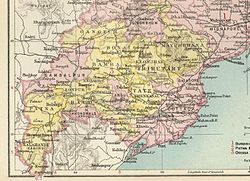Kalahandi State
| Kalahandi State Karond State | |||||||||
|---|---|---|---|---|---|---|---|---|---|
| Princely State of British India | |||||||||
| 1005–1948 | |||||||||
 Kalahandi State in the Imperial Gazetteer of India | |||||||||
| Capital | Bhawanipatna | ||||||||
| Area | |||||||||
• 1892 | 9,700 km2 (3,700 sq mi) | ||||||||
| Population | |||||||||
• 1892 | 224,548 | ||||||||
| History | |||||||||
| History | |||||||||
• Established | 1005 | ||||||||
| 1948 | |||||||||
| |||||||||
| Today part of | Odisha, India | ||||||||
Kalahandi State, also known as Karond State,[1] was one of the princely states of India during the period of the British Raj. It was recognized as a state in 1874[2] and had its capital in Bhawanipatna. Its last ruler signed the accession to the Indian Union on 1 January 1948.
History[edit | edit source]
Kalahandi was the largest of the 26 Feudatory states of Odisha. According to local tradition, the state originated with Raja Raghunath Sai of the Naga dynasty who traced descent from the Nagabanshis of Chotanagpur[3] of Eastern India, beginning to rule the Kalahandi area in 1005 CE.[4][5][6] As per the traditional records preserved in Kalahandi Darbar, the Nagas succeeded the Gangas in Kalahandi when the last Ganga Governor of Kalahandi, Jagannath Deo's only daughter was married to Raghunath Sai, a prince of the Naga clan. However, historians have disputed the early date for the establishment of Naga dynasty rule in Kalahandi but most agree the Nagas succeeded the Gangas as the feudatories in the region during the 15th century taking advantage of the weakness of the central authority as the power of the Eastern Ganga dynasty started to decline in Odisha.[5] Hence the state's coat of arms had two cobras facing each other.[7] and the presiding deity of the dynasty is Goddess Manikeswari.[8][9]
In August 1947 Kalahandi became part of the Eastern States Union, an entity that was formed in Rajpur and that gathered most of the princely states of Orissa and Chhattisgarh. The Eastern States Union was dissolved in 1948.[10] The formerly princely state's territory is now within Kalahandi District.
Rulers[edit | edit source]
The rulers of Kalahandi princely state were granted a hereditary salute of 9 guns by the British.[11]
- Rulers of the Naga Dynasty of Kalahandi
- Raghunath Sai (1005–1040 AD)
- Pratap Narayan Deo (1040–1072 AD)
- Birabar Deo (1072–1108 AD)
- Jugasai Deo I (1108–1142 AD)
- Udenarayan Deo (1142–1173 AD)
- Harichandra Deo (1173–1201 AD)
- Ramachandra Deo (1201–1234 AD)
- Gopinath Deo (1234–1271 AD)
- Balabhadra Deo (1271–1306 AD)
- Raghuraj Deo (1306–1337 AD)
- Rai Singh Deo I (1337–1366 AD)
- Haria Deo (1366–1400 AD)
- Jugasai Deo II (1400–1436 AD)
- Pratap Narayan Deo II (1436–1468 AD)
- Hari Rudra Deo (1468–1496 AD)
- Anku Deo (1496–1528 AD)
- Pratap Deo (1528–1564 AD)
- Raghunath Deo (1564–1594 AD)
- Biswambhar Deo (1594–1627 AD)
- Rai Singh Deo II (1627–1658 AD)
- Dusmant Deo (1658–1693 AD)
- Jugasai Deo III (1693–1721 AD)
- Khadag Rai Deo (1721–1747 AD)
- Rai Singh Deo III (1747–1771 AD)
- Purusottam Deo (1771–1796 AD)
- Jugasai Dei IV (1796–1831 AD)
- Fateh Narayan Deo (1831–1853 AD)
- Udit Pratap Deo I (1853–1881 AD)
- Raghu Keshari De (1894–1897 AD)
- Court of Wards (1897–1917 AD)
- Brajamohan Deo (1917–1939 AD)
- Pratap Keshari Deo (1939-1947 AD)
Titular[edit | edit source]
- Pratap Keshari Deo (1948- 8 October 2001)
- Udit Pratap Deo II (8 October 2001 – 2 November 2019)
- Anant Pratap Deo (2 November 2019-current)
Gallery[edit | edit source]
See also[edit | edit source]
References[edit | edit source]
- ↑ Chisholm, Hugh, ed. (1911). . Encyclopædia Britannica. Vol. 15 (11th ed.). Cambridge University Press. p. 637.
- ↑ Indian Princely States
- ↑ ODISHA DISTRICT GAZETTEERS KALAHANDI (PDF), GAD, Govt of Odisha, 1988, p. 53
- ↑ ODISHA DISTRICT GAZETTEERS KALAHANDI (PDF), GAD, Govt of Odisha, 1988, pp. 53–71
- ↑ 5.0 5.1 J. P Singh Deo, History and Culture of Kalahandi: Political Scenario of Kalahandi, Feb 2010, page: 41-43
- ↑ "Archived copy". Archived from the original on 23 September 2010. Retrieved 11 November 2010.
{{cite web}}: CS1 maint: archived copy as title (link) - ↑ Malleson, G. B. An historical sketch of the native states of India, London 1875, Reprint Delhi 1984
- ↑ Uma Shankar Kar (September 2009), Goddesses Manikesvari and Lankesvari (PDF), Orissa Review
- ↑ Biswajit Pradhan (2001), THE HISTORY OF NAGA CULT AND NAGA FESTIVALS IN ORISSA, Indian History Congress, p. 3
- ↑ Sadhna Sharma ed. States Politics in India, 1995, p. 273
- ↑ Princely States of India
External links[edit | edit source]
Coordinates: 20°04′59″N 83°12′00″E / 20.083°N 83.2°E



